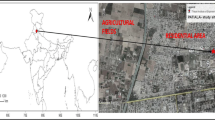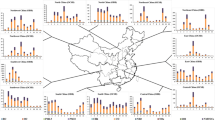Abstract
Based on MODIS images, large-scale flow field charts and environmental monitoring data, we thoroughly analyzed the spatial distribution of wheat straw burning in North China, with focus on its environmental impacts on the air quality of Beijing and pollution transport paths. And we anatomized changes of air quality in Beijing under the impacts of pollution generated by wheat straw burning around. The results indicate that: (1) The North China Plain, a winter-wheat growing area, is the main source of pollutants induced by wheat straw burning in Beijing. The direction of south-west is the dominant heavy pollution transport path. (2) Impacts of wheat straw burning on air quality are mainly manifested by significantly increasing CO concentration. (3) Precursors of O3 generated by wheat straw burning, combining with favorable meteorological conditions, can induce increasing O3 concentration greatly. NO concentration will be greatly increased due to decreasing O3 concentration at night. (4) Atmospheric particles, especially the fine ones, from wheat straw burning exert considerable influence on Beijing air quality. (5) Different contributions of wheat straw burning to pollutants are identified. Ratios of PM10/SO2, CO/SO2, etc., can be applied to indicate pollution extent of wheat straw burning. High ratios of PM10/SO2 and CO/SO2 show that the air quality was heavily impacted by wheat straw burning and these ratios can be employed as indicators of contribution of wheat straw burning to the degradation of Beijing air quality. (6) Randomness of wheat straw burning activities renders random outbreak of air pollution of this type. Regional and extensive wheat straw burning activities can cause serious air pollution event.
Similar content being viewed by others
References
Levine J S, Cofer W R, Cahoon D R, et al. Biomass burning: A driver for global change. Environ Sci Technol, 1995, 29(3): 120–125
Koppmann R, Czapiewski K V, Reid J S. A review of biomass burning emissions, part I: Gaseous emissions of carbon monoxide, methane, volatile organic compounds, and nitrogen containing compounds. Atmos Chem Phys Discuss, 2005, 5: 10455–10516
Andreae M O, Jones C D, Cox P M. Strong present-day aerosol cooling implies a hot future. Nature, 2005, 435(7046): 1187–1190
Editorial Committee on Rural Energy Yearbook of China. Rural Energy Yearbook of China (in Chinese). Beijing: China Agriculture Press, 1998. 28–35
Wang A L, Gao W S, Hong C M. Study on the ecological effect of crop residues burned or incorporated in field in north central irrigated area of China. Chin J Eco-agriculture (in Chinese), 2003, 11(1): 142–144
Cao G L, Zhang X Y, Wang Y Q, et al. Evaluation of atmospheric pollutants discharged from biomass open burning in China continent. Chin Sci Bull, 2008, 53(5)
Haysa M D, Fine P M, Geron C D, et al. Open burning of agricultural biomass: Physical and chemical properties of particle-phase emissions. Atmos Environ, 2005, 39(36): 6747–6764
Dhammapala R, Claiborn C, Corkill J, et al. Particulate emissions from wheat and Kentucky bluegrass stubble burning in eastern Washington and northern Idaho. Atmos Environ, 2006, 40(6): 1007–1015
Yan X, Ohara T, Akimoto H. Bottom-up estimate of biomass burning in mainland China. Atmos Environ, 2006, 40(27): 5262–5273
Zhao Q Y, Li X Z, Chen T. The influence of wheat straw burning on polycyclic aromatic hydrocarbons in atmospheric particles. Rock Miner Anal (in Chinese), 2003, 22(14): 273–276
Zheng X Y, Liu X D, Zhao F H, et al. Seasonal characteristics of biomass burning contribution to Beijing aerosol. Sci China Ser B-Chem, 2005, 48(5): 481–488
Li L J, Wang Y, Zhang Q, et al. Spatial distribution of aerosol pollution based on MODIS data over Beijing, China. J Environ Sci-China, 2007, 19: 955–960
Wang Y, Jin J, Li L J, et al. Analyzing natural source apportionment of PM10 based on the ratio of PM10 to CO in Beijing. Acta Sci Circumst (in Chinese), 2006, 26(7): 1203–1208
Beguma B A, Kim E, Jeong C H, et al. Evaluation of the potential source contribution function using the 2002 Quebec forest fire episode. Atmos Environ, 2005, 39(20): 3719–3724
Streets D G, Bond T C, Carmichael G R, et al. An inventory of gaseous and primary aerosol emissions in Asia in the year 2000. J Geophys Res, 2003, 108(D21): 8809, 1–23
Reddy M S, Venkataraman C. Inventory of aerosol and sulphur dioxide emissions from India. Part II—Biomass combustion. Atmos Environ, 2002, 36(4): 699–712
Wang H X, Tang X Y, Wang M L, et al. Characteristics of observed trace gaseous pollutants in the Yangtze Delta. Sci China Ser D-Earth Sci, 2003, 33(4): 397–404
Duan F K, Lu Y Q, Di Y A, et al. Influence of straw burning on the air quality in Beijing. Environ monit China (in Chinese), 2001, 17(13): 8–11
Author information
Authors and Affiliations
Corresponding author
Additional information
Supported by the 985 Project of Central University for Nationalities, China (Grant No. CUN 985-3-3)
Rights and permissions
About this article
Cite this article
Li, L., Wang, Y., Zhang, Q. et al. Wheat straw burning and its associated impacts on Beijing air quality. Sci. China Ser. D-Earth Sci. 51, 403–414 (2008). https://doi.org/10.1007/s11430-008-0021-8
Received:
Accepted:
Issue Date:
DOI: https://doi.org/10.1007/s11430-008-0021-8




